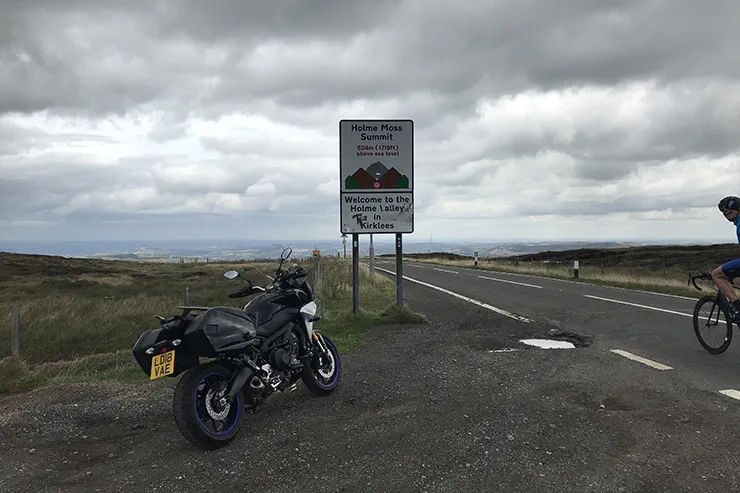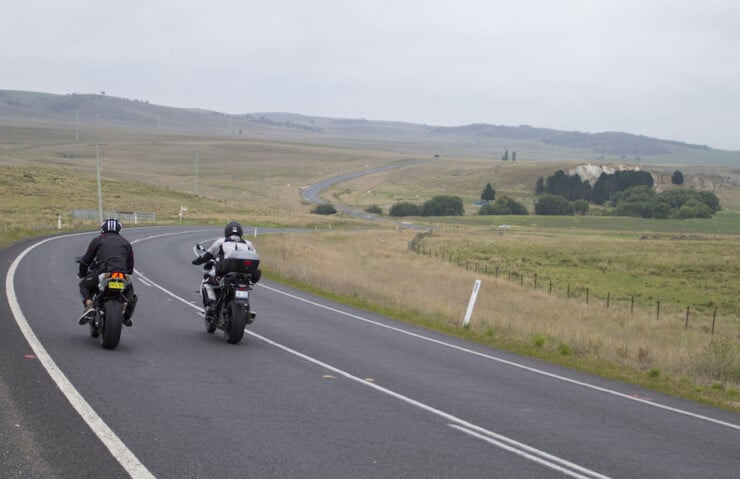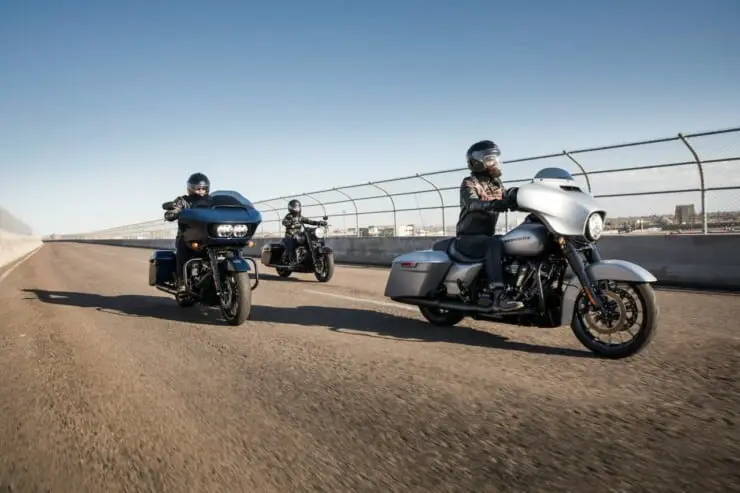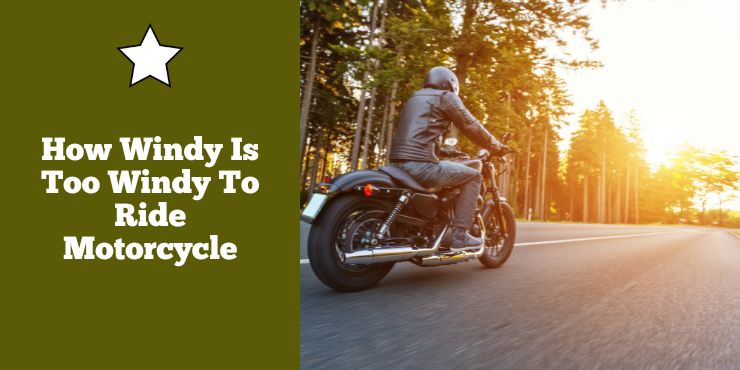Whether you are a seasoned biker or just getting started, one of the most important things you need to consider is the weather and how it can affect your ride. When there is wind in the forecast, it can make it difficult to assess whether it’s safe to ride or not.
Winds over 30-40 mph are generally considered too strong for safe motorcycle riding, as high crosswinds can destabilize the bike and make handling difficult, especially for lighter motorcycles.
In this article, we’ll answer your questions about how windy is too windy to ride motorcycle so you can make an informed decision. Let’s get started!
Understanding windy conditions for motorcyclists
As a motorcyclist, you will encounter a wide variety of weather conditions on the road, including windy conditions. Riding in windy conditions can present unique challenges and safety concerns. Understanding the different types of winds that bikers might encounter will be important for maintaining control, stability, and safety while riding.

Windy conditions refer to periods when there is an increased flow of air or gusts that can affect the stability and control of a bike. These conditions can arise due to several factors, such as weather systems, geographical features, or riding in open areas with minimal windbreaks. Winds can vary in strength, direction, and consistency, and it is important for bikers to be prepared for the challenges posed by different types of winds.
Here are the different types of winds that a motorcyclist may encounter on the road –
#1. Headwinds
Headwinds occur when the wind is blowing directly opposite the direction of travel, hitting the front of the bike. Riding into a headwind can significantly impact the bike’s speed and stability, requiring the rider to exert more effort to maintain forward momentum. Headwinds can be encountered on open roads, highways, or coastal areas, and they might increase fuel consumption and affect the motorcycle’s aerodynamics.
#2. Crosswinds
Crosswinds are winds that blow perpendicular to the direction of travel, hitting the motorcycle from the side. These winds can be quite challenging as they affect the stability and balance of the bike. Crosswinds are common on open plains, bridges, gaps between buildings, or when passing larger vehicles on the roads.
#3. Tailwinds
Tailwinds occur when the wind blows in the same direction as the bike’s travel. While it might seem adventurous to have a tailwind, it can affect handling and braking distances. Tailwinds can increase the bike’s speed and require additional attention to maintain control and avoid unintended acceleration.
#4. Gusty winds
Gusty winds refer to irregular and sudden bursts of wind, varying in intensity and direction. They can occur in any riding situation and demand heightened attention and quick responses. Riding at a slightly lower speed will provide better control and allows you to react more effectively to sudden gusts.
How windy is too windy to ride motorcycle?
This is both an easy and tricky question to answer as different wind gusts have different effects on various types of bikes. The ideal wind speed at which you can drive a bike will be around 15 mph. When you are riding a heavy motorcycle like a Harley-Davidson bike, you must avoid riding at winds above 40 mph. Wind speeds between 25 and 30 mph are considered excessive for small and lightweight bikes. This is why riding motorcycle which is why they aren’t the best conditions for riding either.
Generally, windy conditions between 15 mph and 25 mph are considered to be safe for most cases. When riding motorcycle in 15 mph wind, you won’t have to worry about the wind topping a properly parked bike. Riding motorcycle in 30 mph wind can be potentially dangerous because they might be able to tip bikes. You may ask, when can wind knock a motorcycle over while riding? Winds above 40 mph will likely be enough to blow over most bikes.
With that said, strong winds will affect both when you are riding the bike and also when your bike is sitting idle. There are certain conditions that play a role in defining how windy is too windy to ride a motorcycle and if the wind can cause problems. This includes how big your motorcycle is, the angle of the bike to the road, the condition and type of kickstand, and the angle at which the wind is hitting your bike.
Factors that influence windy conditions for motorcyclists
Windy conditions can significantly impact the riding experience and safety of motorcyclists. Understanding the factors that contribute to these conditions is important for riders to effectively anticipate and adapt to changing wind patterns. Here are the different factors that influence windy conditions for motorcyclists, helping riders make informed decisions and enhancing their safety on the road.
#1. Weather system
Weather systems play a key role in generating windy conditions. High-pressure systems and low-pressure systems are the primary weather patterns that affect wind flow. High-pressure systems typically create calm or light wind conditions whereas low-pressure systems can cause stronger winds. Understanding the weather forecast, including the presence of low-pressure systems or approaching fronts, can help riders anticipate windy conditions.
#2. Topography and geographical features
The terrain and geographical features of an area can greatly impact wind patterns. For instance, mountain passes, canyons, coastal areas, and open plains can channel or obstruct wind flow. This can result in varying wind intensities. Bikers traveling through areas with these geographical features should be prepared for sudden changes in wind strength and direction.
#3. Windbreaks and structures
The presence of windbreaks and structures along the road can alter wind flow and create turbulence. Buildings, trees, bridges, overpasses, and large vehicles can create wind eddies and gusts, making riding conditions more challenging. Bikers should be especially cautious when passing through or alongside windbreaks and structures as the wind behavior can change abruptly.
#4. Time of day
The time of day can also influence wind patterns. In many regions, wind tends to be stronger during certain times of the day. For example, in coastal areas, the afternoon could bring stronger sea breezes while mornings are relatively calmer. Understanding the local wind patterns can help bikers plan their routes and timing accordingly.
#5. Seasonal winds
Certain regions experience seasonal winds that can greatly impact riding conditions. For example, the Santa Ana winds in Southern California or the Mistral winds in the Mediterranean can create powerful gusts. You need to familiarize yourself with the prevalent seasonal winds in your riding area to prepare for their effects.

Effects of windy conditions on motorcycle riding
Windy conditions can have a wide range of effects on the safety, comfort, and motorcycle fuel economy of motorcyclists on the road. Understanding the relationship between windy conditions and these factors will be important for bikers to drive safely and efficiently. This way, they will be able to take appropriate measures when driving to ensure a secure and enjoyable riding experience. Here are the effects of windy conditions on motorcycle riding –
Windy conditions and safety
Strong gusts of wind can affect the stability and control of a motorcycle. Crosswinds, headwinds, and unpredictable gusts can cause your bike to sway, making it challenging to maintain the desired path. This instability can increase the risk of potential accidents, especially at higher speeds or when navigating through curves or crowded roadways. Bikers need to stay vigilant and react promptly to counteract the effects of wind on their bikes.
Riding in windy conditions can impact the rider’s ability to maneuver the motorcycle effectively. Sharp gusts can make it difficult to execute quick lane changes, turns, or evasive maneuvers. It is important for bikers to adjust their riding techniques and be extra cautious when navigating in windy conditions to ensure they have optimal control over their motorcycles.
Wind passing through structures or vehicles can also create turbulence. This can cause sudden changes in wind speed and direction. Turbulence can be particularly challenging for bikers as it can lead to unexpected handling issues and loss of stability. When passing trucks, buses, or traveling through areas having windbreaks, riders need to exercise caution and be prepared for turbulence that might affect their bike’s stability.
Windy conditions and comfort
Riding in constant windy conditions can be physically and mentally tiring for bikers. Constantly battling against strong headwinds or crosswinds will require riders to exert more effort to maintain control and stability. This increased physical strain can result in rider fatigue over longer distances, affecting concentration and reaction times. Fatigue can often decrease overall comfort and increase the risk of accidents.
Riding in windy conditions can also result in increased noise levels and wind blasts. Strong headwinds can generate loud wind noise around the rider’s helmet, making it difficult to hear important auditory cues from the surroundings. The forceful wind blast can also exert pressure on the rider’s body, resulting in discomfort and fatigue. Wearing proper protective gear, including a well-fitted helmet and wind-resistant clothing can help mitigate these effects and improve comfort.
Motorcyclists might have to adjust their riding position to counteract the effects of wind on their motorcycles. This can involve adopting a more aerodynamic posture by tucking in closer to the tank or adjusting the body position to maintain balance and stability. Experimenting with different riding positions can help the rider find the most comfortable and secure posture when riding in windy conditions.
Windy conditions and motorcycle maintenance
Windy conditions often result in increased dust and debris on the roads. Driving in such conditions can expose the bike to a higher risk of accumulating dirt, dust, and other debris. These particles can clog air filters, compromise engine performance, and accelerate wear and tear. Regular cleaning and maintenance, including air filter inspection and cleaning, can help mitigate the effects of dusty and windy conditions on the motorcycle’s components.
Riding in windy conditions, especially against strong headwinds or crosswinds, places added stress on various components of the bike. The wind’s force can strain suspension systems, bearings, and other moving parts, leading to accelerated wear. It is important for bikers to perform regular inspections and maintain checks to identify and address any potential issues caused by windy conditions.
Windy conditions may cause dirt, dust, and debris to accumulate on the motorcycle’s chain or drive belt. This buildup can affect the performance and longevity of these crucial components. Regular cleaning, lubrication, and proper tension adjustment of the chain or drive belt become even more critical in windy conditions to ensure optimal functionality and reduce the risk of premature wear.

Windy conditions and motorcycle fuel economy
Riding against strong headwinds can create increased aerodynamic drag on the motorcycle, requiring the engine to work harder to maintain speed. This extra effort can result in higher fuel consumption and decreased fuel economy. Riders must be mindful of the impact of headwinds on their motorcycle’s fuel efficiency and adjust their riding technique and speeds accordingly to optimize fuel economy.
In windy conditions, bikers often have to make frequent speed adjustments for counteracting the effects of crosswinds and maintain stability. Constant acceleration and deceleration can negatively impact fuel economy as sudden changes in speed require more fuel to be burned. Maintaining a consistent and steady speed whenever possible can help minimize fuel consumption.
Crosswinds and gusts can also affect the bike’s stability and create lateral forces on the tires. These forces increase rolling resistance, requiring the engine to work harder to maintain speed. By ensuring optimal tire pressure and proper tire maintenance, motorcyclists can reduce rolling resistance and improve fuel efficiency.
Preparation before riding in windy conditions
Riding a motorcycle in windy conditions requires extra caution and preparation to ensure a safe and comfortable journey. Strong gusts of wind can greatly affect stability, control, and visibility, making it essential for bikers to take necessary precautions. Here are the important steps to consider when preparing to ride a motorcycle in windy conditions, helping you enhance your safety and confidence on the road.
#1. Check weather forecasts
Before you embark on your ride, check the weather forecasts for your route and destination. Pay close attention to wind speed and direction predictions as these factors will greatly influence your riding experience.
Ideally, you should avoid riding during extreme wind conditions whenever possible. However, if you must ride, being aware of the windy conditions in advance will help you prepare yourself mentally and physically.
#2. Choose appropriate riding gear
Selecting the right riding gear will be crucial when riding in windy conditions. You must opt for a well-fitted helmet with a face shield or goggles to protect your eyes from dust, debris, and windblast. Wear a wind-resistant jacket, pants, and gloves to reduce wind chill and maintain comfort. Make sure your gear is properly fastened and snug to prevent flapping in the wind, which can be distracting and uncomfortable.
#3. Secure luggage and loose items
Before you hit the road, you must double-check that any luggage or personal belongings are securely fastened to your bike. Strong gusts of wind can easily dislodge or shift loose items, posing a hazard to both you and other riders. You must securely strap down bags, backpacks, and any other loose objects to prevent them from interfering with your balance or becoming projectiles.
#4. Perform a motorcycle safety check
Conduct a thorough safety inspection of your bike before riding in windy conditions. Check tire pressure and tread depth to ensure optimal traction and stability. Inspect the brakes, suspension, and steering components for any signs of wear or damage. Adequate maintenance and a mechanically sound motorcycle will be important for safe riding, especially when you are facing challenging windy conditions.
#5. Plan your route and a safe shelter
If possible, you should be planning your route to avoid areas that are prone to strong winds or open plains with minimal windbreaks. If you ever find yourself caught up in unexpectedly severe wind conditions, you must seek shelter in a safe location until the wind subsides. Parking behind buildings or other structures can provide temporary respite from strong gusts, allowing you to regain your composure and evaluate the situation.
Essential tips to keep in mind when riding a motorcycle in windy conditions
Riding a bike in windy conditions will require extra skill, focus, and adaptability. Strong gusts of wind can greatly affect your safety and overall riding experience. However, with the right techniques, precautions, and essential tips, you will be able to confidently navigate through windy conditions and enjoy your ride. Here are a few valuable tips to enhance your safety and comfort when riding a motorcycle in windy conditions.
#1. Maintain a firm and relaxed grip
When you’re riding in windy conditions, it’ll be important to maintain a firm grip on the handlebars, ensuring you have optimal control over your bike. However, it is equally important to remain relaxed to avoid tension in your arms and upper body. A relaxed posture will help absorb the effects of gusts and allows you to make smoother adjustments.
#2. Adjust your body position
Positioning your body correctly can significantly improve stability and control in windy conditions. When you’re facing a headwind, you should tuck in closer to the fuel tank to minimize wind resistance and maintain a streamlined profile. For crosswinds, you need to lean slightly into the wind while keeping the upper body relaxed and aligned with the motorcycle. These adjustments help counteract the forces of the wind and enhance your overall stability.
#3. Anticipate gusts and wind direction changes
Stay alert and anticipate gusts and changes in wind direction. Keep an eye out for trees, flags, or other environmental cues that indicate the intensity and direction of the wind. Anticipating these changes will allow you to prepare and make timely adjustments to the riding position and speed, ensuring smoother handling and reducing the risk of instability.
#4. Reduce the speed
In windy conditions, it is advised that you should reduce your speed when driving. Riding at a slightly lower speed provides you with better control over your bike, increases stability, and allows you to react more effectively to sudden gusts. Adjust your speed according to the wind intensity, road conditions, and your comfort level.
#5. Be mindful of wind turbulence
Certain areas like bridges, tunnels, or gaps between buildings can create wind turbulence. These turbulent zones can have a significant impact on your bike’s stability. Be prepared for sudden changes in wind intensity and keep a steady hand on the handlebars. You should maintain a consistent speed and avoid making sudden maneuvers when entering or exiting these areas.
#6. Keep a safe distance from large vehicles
Large vehicles like trucks or buses can create a “wind shadow” effect, causing turbulent air behind them. Maintain a safe distance when overtaking or following these vehicles to avoid sudden shifts in wind patterns. You should be prepared for the change in wind intensity as you pass or re-enter the airflow around these vehicles.
#7. Use your body as a wind buffer
When you’re riding in crosswinds, using your body as a wind buffer will help maintain stability. By slightly leaning into the wind, you’ll be able to counterbalance the lateral force and maintain a straighter path. However, you should avoid excessive leaning as it might compromise your control and stability.
#8. Stay visible and use signals
In windy conditions, visibility will be crucial. Ensure that your bike’s lights are functioning correctly and consider wearing high-visibility gear to enhance your presence on the road. Make use of hand signals and indicators effectively to communicate your intentions to other road users, especially when wind noise might make it difficult for them to hear your bike’s engine.
FAQs
What are the safety risks of riding a motorcycle in high winds?
High winds can create unsafe riding conditions as strong winds can significantly reduce visibility, stability, and control of the motorcycle. Strong gusts can also cause the motorcycle to drift or move in a direction that the rider did not intend. In addition, high winds can blow debris and other objects into the path of the motorcycle, creating a hazardous situation.
How can riders stay safe when riding a motorcycle in windy conditions?
When riding in windy conditions, riders should take extra precautions to ensure their safety. It is important to reduce speed, increase the following distance between vehicles, and avoid riding in gusty conditions. Riders should also wear protective clothing, including a helmet and windproof jacket, to reduce the impact of the wind and debris.
What is the maximum wind speed recommended for riding a motorcycle?
The maximum wind speed recommended for riding a motorcycle varies depending on the type of motorcycle and the rider’s experience level. Generally, most riders should avoid riding in winds exceeding 25 mph. Experienced riders may be able to ride in higher wind speeds, but it is important to use caution and be aware of changing conditions.

